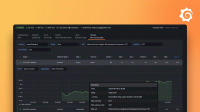Caution
Grafana Alloy is the new name for our distribution of the OTel collector. Grafana Agent has been deprecated and is in Long-Term Support (LTS) through October 31, 2025. Grafana Agent will reach an End-of-Life (EOL) on November 1, 2025. Read more about why we recommend migrating to Grafana Alloy.
Set up meta-monitoring
You can configure Grafana Agent Flow to collect its own telemetry and forward it to the backend of your choosing.
This topic describes how to collect and forward Grafana Agent Flow’s metrics, logs and traces data.
Components and configuration blocks used in this topic
Before you begin
- Identify where to send Grafana Agent Flow’s telemetry data.
- Be familiar with the concept of Components in Grafana Agent Flow.
Meta-monitoring metrics
Grafana Agent Flow exposes its internal metrics using the Prometheus exposition format.
In this task, you will use the prometheus.exporter.self and prometheus.scrape components to scrape Grafana Agent Flow’s internal metrics and forward it to compatible Grafana Agent Flow components.
Add the following
prometheus.exporter.selfcomponent to your configuration. The component accepts no arguments.prometheus.exporter.self "<SELF_LABEL>" { }Add the following
prometheus.scrapecomponent to your configuration file.prometheus.scrape "<SCRAPE_LABEL>" { targets = prometheus.exporter.<SELF_LABEL>.default.targets forward_to = [<METRICS_RECEIVER_LIST>] }Replace the following:
<SELF_LABEL>: The label for the component such asdefaultormetamonitoring. The label must be unique across allprometheus.exporter.selfcomponents in the same configuration file.<SCRAPE_LABEL>: The label for the scrape component such asdefault. The label must be unique across allprometheus.scrapecomponents in the same configuration file.<METRICS_RECEIVER_LIST>: A comma-delimited list of component receivers to forward metrics to. For example, to send to an existing remote write component, useprometheus.remote_write.WRITE_LABEL.receiver. Similarly, to send data to an existing relabeling component, useprometheus.relabel.PROCESS_LABEL.receiver. To use data in the OTLP format, you can send data to an existing converter component, likeotelcol.receiver.prometheus.OTEL.receiver.
The following example demonstrates configuring a possible sequence of components.
prometheus.exporter.self "default" {
}
prometheus.scrape "metamonitoring" {
targets = prometheus.exporter.self.default.targets
forward_to = [prometheus.remote_write.default.receiver]
}
prometheus.remote_write "default" {
endpoint {
url = "http://mimir:9009/api/v1/push"
}
}Meta-monitoring logs
The logging block defines the logging behavior of Grafana Agent Flow.
In this task, you will use the logging block to forward Grafana Agent Flow’s logs to a compatible component. The block is specified without a label and can only be provided once per configuration file.
Add the following
loggingconfiguration block to the top level of your configuration file.logging { level = "<LOG_LEVEL>" format = "<LOG_FORMAT>" write_to = [<LOGS_RECEIVER_LIST>] }Replace the following:
<LOG_LEVEL>: The log level to use for Grafana Agent Flow’s logs. If the attribute isn’t set, it defaults toinfo.<LOG_FORMAT>: The log format to use for Grafana Agent Flow’s logs. If the attribute isn’t set, it defaults tologfmt.<LOGS_RECEIVER_LIST>: A comma-delimited list of component receivers to forward logs to. For example, to send to an existing processing component, useloki.process.PROCESS_LABEL.receiver. Similarly, to send data to an existing relabeling component, useloki.relabel.PROCESS_LABEL.receiver. To use data in the OTLP format, you can send data to an existing converter component, likeotelcol.receiver.loki.OTEL.receiver.
The following example demonstrates configuring the logging block and sending to a compatible component.
logging {
level = "warn"
format = "json"
write_to = [loki.write.default.receiver]
}
loki.write "default" {
endpoint {
url = "http://loki:3100/loki/api/v1/push"
}
}Meta-monitoring traces
The tracing block defines the tracing behavior of Grafana Agent Flow.
In this task you will use the tracing block to forward Grafana Agent Flow internal traces to a compatible component. The block is specified without a label and can only be provided once per configuration file.
Add the following
tracingconfiguration block to the top level of your configuration file.tracing { sampling_fraction = <SAMPLING_FRACTION> write_to = [<TRACES_RECEIVER_LIST>] }Replace the following:
<SAMPLING_FRACTION>: The fraction of traces to keep. If the attribute isn’t set, it defaults to0.1.<TRACES_RECEIVER_LIST>: A comma-delimited list of component receivers to forward traces to. For example, to send to an existing OpenTelemetry exporter component useotelcol.exporter.otlp.EXPORT_LABEL.input.
The following example demonstrates configuring the tracing block and sending to a compatible component.
tracing {
sampling_fraction = 0.1
write_to = [otelcol.exporter.otlp.default.input]
}
otelcol.exporter.otlp "default" {
client {
endpoint = "tempo:4317"
}
}


